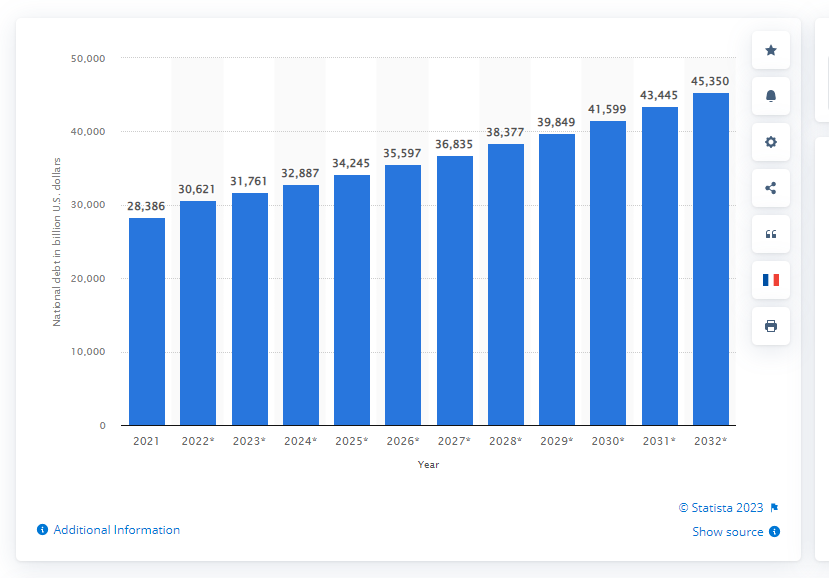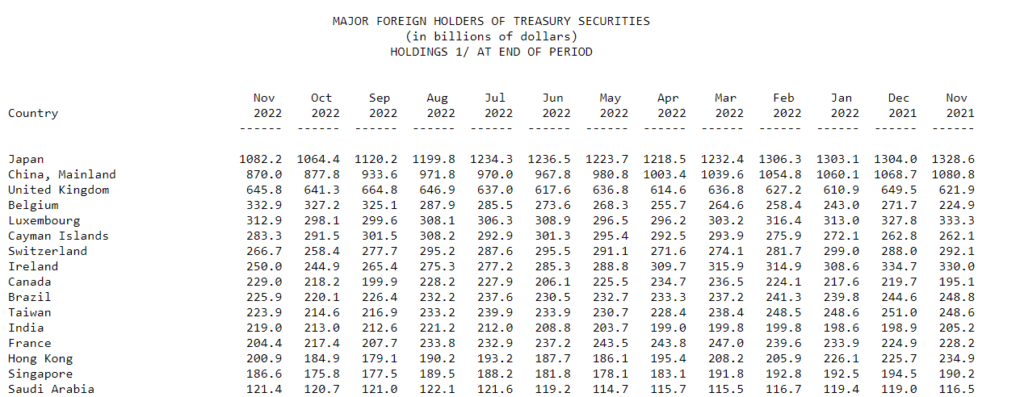Key Takeaways:
- US National Debt has reached worrying heights
- The economic slow down caused by the Covid 19 pandemic has contributed to the growing government debt
- China and Japan are among the largest foreign holders of US Treasury Securities
YEREVAN (CoinChapter.com) — The US national debt has reached $31.5 trillion, prompting economists to predict serious economic consequences.
The country could be looking at a period of higher interest rates, tax hikes, and spending cuts. Moreover, the event of the US government accumulating more debt could exacerbate the problems, like throwing the country into a fiscal crisis.

Ringing the alarm bells, the Treasury Department announced last month it will start taking extraordinary measures to keep the government paying its bills to avoid a catastrophic default.

What is the current US national debt?
Precisely, the US national debt reached the debt ceiling of $31.41 trillion last month, creating a political storm between the Biden Administration and its Republican opponents.
But, according to Truth in Accounting, the actual US debt is much higher at over $100 trillion. According to their calculations, the administration’s published National Debt consists of debt held by the public and intragovernmental holdings. These include debt held by Social Security and Medicare trust funds.

However, even the official figure of $31 trillion puts an average debt of $94,280 per person in America.
Recommended: Why are so many American citizens reeling under credit card debt?
Why is debt so high in the US?
The US government has always been in debt. Aside from 1835, the amount has grown steadily, crossing the $1 billion mark for the first time in the early 1860s. By the end of the American Civil War in 1865, the national debt had reached around $2.7 billion.
A country’s national debt spikes during years of increasing government spending and tax cuts. Unemployment and a drop in individual income all contribute to the growth of debt.
During WWI, when Washington went on a spending spree to fund its war efforts, the country’s debt reached $22 billion. Subsequent events, including the war in Afghanistan and the great depression of 2008 burnt a hole in the government’s budget.

More recently, the Covid-19 pandemic and its economic consequences forced the US government to increase spending by 50% between FY2019 to FY2021.
When former US President Donald Trump took office in 2017, he inherited deficits of $19.947 trillion. By the time he completed his term, this number had increased by $7.8 trillion, reaching $27.751 trillion.
The national debt has increased by $2.12 trillion since Joe Biden won the elections. The Government has looked to borrow more to cover the annual deficit.
Other factors, including the aging population and the ever-increasing health and welfare benefits, have become a burden on the US budget. The US Treasury does not collect enough taxes to cover the rising costs.
This rising disparity between spending and revenues has caused the national debt to surge to record levels, crossing the debt ceiling.
Who owns the US national debt?
The US National Debt is divided into intergovernmental debt and public debt. While the former comprises debts the Government owes to other federal agencies and entities within the country, foreign Governments hold a large chunk of the latter.
According to treasury figures, intragovernmental holdings totaled more than $6.89 trillion, or about a fifth of the total outstanding U.S. debt. These include debt the US government owes to Medicare, Social Security, and various retirement funds.

Besides foreign governments, US banks, individual investors, the US Federal Reserve, and state and local governments also own the size of the public debt. Other players include insurance companies, savings bonds, and pension funds.
As per official figures, around $24.6 trillion of the national debt in the US is public debt.
How much debt does the US owe China?
China is one of the largest owners of the country’s debt. According to data from Investopedia, Beijing holds $870 billion in Treasury holdings as of November 2022.
China is second to only its other Asian counterpart, Japan. The relatively smaller island nation holds $1.08 trillion in Treasury securities. This constitutes around 14.87% of the total foreign-owned U.S. debt.

Other major foreign debt owners include the United Kingdom, which holds $645.8 billion or 8.87% of US foreign debt, and Belgium, which accounts for $332.9 billion or 4.57% of total foreign debt.
Luxembourg, meanwhile, is the fifth-largest holder of U.S. debt among foreign countries. It holds $312.9 billion in US Treasuries, which is equal to 4.3%.
Can the US pay off its debt? What happens if it doesn’t?
The United States has always held national debt. While the debt ceiling has changed, subsequent Governments have, for the most part, maintained a healthy debt limit.
Andrew Jackson is the only US president to pay off the national debt. He famously did so in 1835. Other than him, no one has been able to achieve this. By the looks of it, the Biden administration is not going to do it either.
All the current Government can do is keep the debt within the stipulated ceiling.
If the US authorities run out of money, they can risk a default. That would have catastrophic consequences. The country will experience even higher interest rates. The stock market will crash, and millions of people will be rendered jobless.
Defaulting could directly impact several households. The Biden Administration will be forced to cut federal benefits such as Social Security, Medicare, and Medicaid. Moreover, many families will lose their federal aid related to nutrition, veterans, and housing.
Alternatively, the Government can lobby for the US Congress to abolish the death ceiling altogether. However, considering that the Republicans hold control over the House of Representatives, the chances of that happening are slim.
Frequently Asked Questions (FAQ)
US national debt reached the debt ceiling of $31.41 trillion last month, creating a political storm between the Biden Administration and its Republican opponents.
During WWI, when Washington went on a spending spree to fund its war efforts, the country’s debt reached $22 billion. Subsequent events, including the war in Afghanistan and the great depression of 2008 burnt a hole in the government’s budget.
The US National Debt is divided into intergovernmental debt and public debt. As per official figures, around $24.6 trillion of the national debt in the US is public debt.
China is one of the largest owners of the country’s debt. According to data from Investopedia, Beijing holds $870 billion in Treasury holdings as of November 2022.
All the Governments can do is keep the debt within the stipulated ceiling. If the US authorities run out of money, they can risk a default. That would have catastrophic consequences. The country will experience even higher interest rates.


